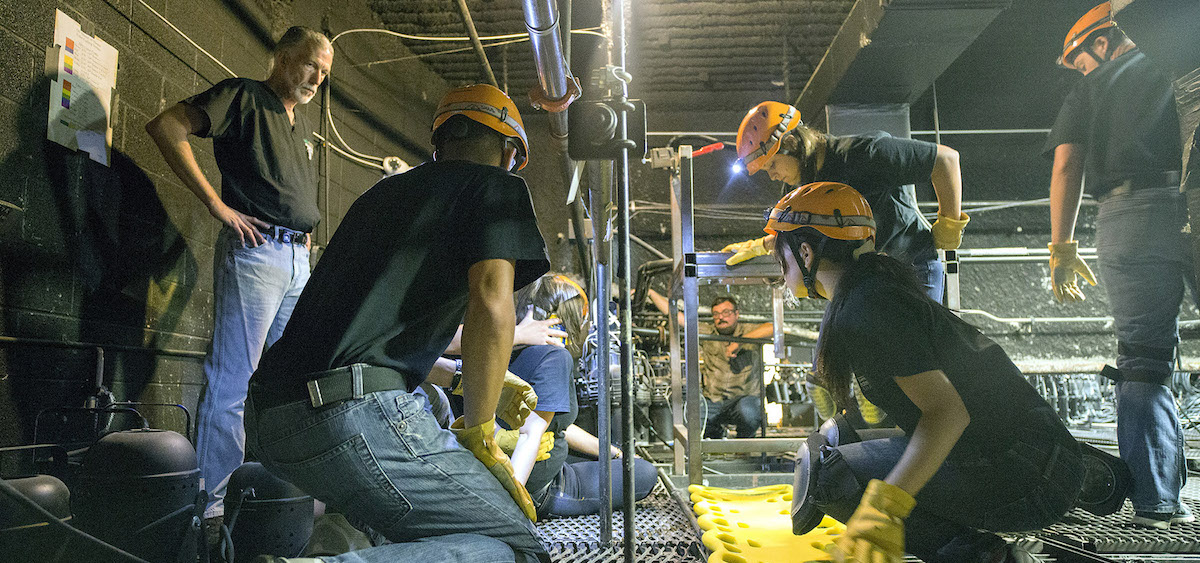Culture

OU Theater, Health Sciences Students Partner to Save Lives
< < Back to woubStudents currently in rotation at the SHAPe Clinic, part of the School of Health Sciences and Wellness at Ohio University, recently performed extrication drills in the lighting grid of The Forum Theater.
Dr. Jeff Russell led teams of undergraduate and graduate students in the simulation of safe and effective removal of injured bodies from the complex (high-voltage) environment of a lighting grid, a maze-like structure of steel platforms, lighting equipment and power cables hanging high above the theater stage.
During the in-service, students worked together learning how to respond to emergency scenarios they might encounter in a real life situation while working in a performing arts setting. These sessions benefit students from both the SHAPe Clinic and the School of Theater.
The Clinic for Science and Health in Artistic Performance (SHAPe Clinic) is a place where injured performing artists at Ohio University can be evaluated, treated and receive health and wellness advice from licensed athletic trainers who have the specialized equipment and knowledge to treat their injuries.
The College of Fine Arts and the Division of Athletic Training in the College of Health Sciences and Professions collaborated to establish the clinic in 2013.
“If we can get someone out of a lighting grid, we can get them out of anywhere,” said Jeff Russell, the Director of the SHAPe Clinic. “The complexities of the theater architecture present unique challenges, different from those of say, a football field.”
Megan Bane and Emily Griswold are both graduate students in the College of Health Sciences and athletic trainers in the SHAPe Clinic. “I was responsible for running through one of the scenarios with my students and my co-workers,” Bane said. “It was great to be exposed to the situation and think through my actions to practice what I would do in a real life event.” Griswold said she thinks “it’s important that we practice this in the most realistic setting possible, and for me working in the theater, this is a potential risk, and something I feel much more prepared to handle.”
Russell said the event was very successful. The four undergraduate students had not previously been exposed to that type of work, so they were quite enthusiastic. “These types of in-services are essential, said Russell, “because of the extreme difficulty of extricating someone from the grid.”
“We’re trying to strategically encourage the role of safety in every aspect of theater production,” said Lowell Jacobs, a master audio and master electrician in the School of Theater, and a longtime theater technician with a “vested interest in increasing safety and encouraging emergency preparedness for all theater students.”
Shelley Delaney, an associate professor of performance and head of the performance area in the School of Theater, said this collaboration “is valued beyond measure, principally as a service that keeps the students healthy, but also because it makes them feel respected and valued.”
Russell emphasized that there remains no comparable program in the country like that of the SHAPe Clinic, which educates performing arts trainers in a collaborative role in theatrical education programs.
“Someone from the SHAPe Clinic is backstage at every dress rehearsal and performance,” said Michael Lincoln, the director of the School of Theater. “Students leaving our program will not commonly see performing arts trainers when they leave Ohio University. When our students enter the profession they will spread the message about this cutting-edge program.” He hopes this will improve the professional trainer role within theaters and performing arts venues.

